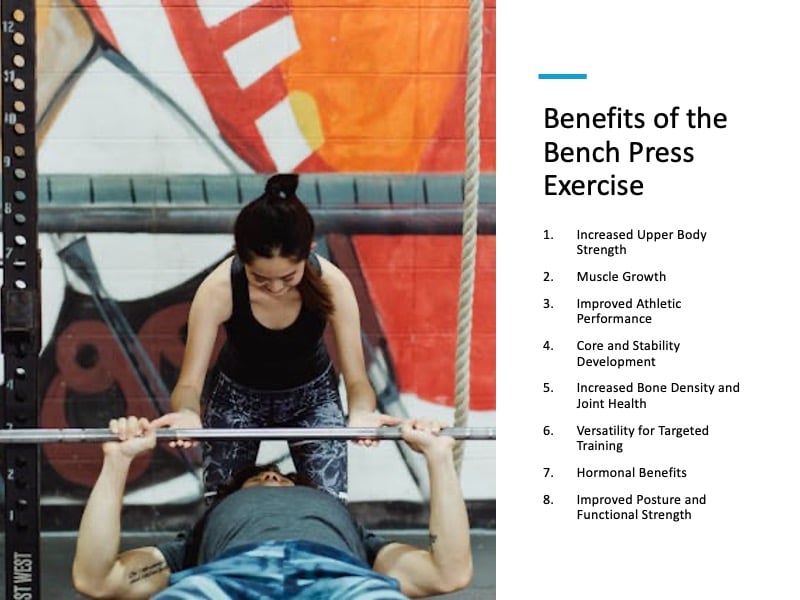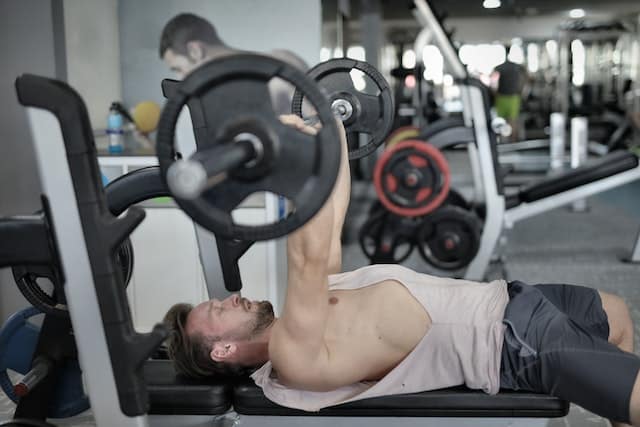Bench Press Exercise: Benefits, Muscles Worked, & Best Tips
The bench press is more than just a gym staple—it’s a test of upper body strength and a favorite among athletes, bodybuilders, and anyone looking to build serious power. Yet, despite its popularity, the bench press often causes confusion, leading to plateaus, poor form, and even injury.
If that’s you, you’re not alone!
I spent years doing heavy bench presses to come out with some cool stories and bad shoulders (my all-time 1rm is 365lbs!).
Whether you’re trying to break a personal record or perfect your technique, understanding the real benefits, muscles worked, and how to safely progress is key.
In this guide, we’ll explore what makes the bench press so effective, share tips to improve your lift, and clear up common myths so you can bench confidently!
Benefits of the Bench Press Exercise

The bench press is a foundational compound exercise that activates multiple joints and recruits several major muscle groups.
Its versatility and efficiency make it a cornerstone of upper-body strength training, offering a broad range of benefits for both athletes and fitness enthusiasts.
By integrating the bench press into your fitness regimen with proper technique and progression, you can enjoy its full spectrum of benefits, from enhanced strength and muscle mass to improved athletic performance and overall health.
Increased Upper Body Strength
The bench press primarily targets the pectoralis major, triceps brachii, and anterior deltoid, key muscles for upper body strength.
Regularly incorporating the bench press into your routine can improve your ability to perform everyday tasks like lifting heavy objects, pushing doors, or carrying groceries.
For athletes, this strength enhances their ability to generate force in pushing and pressing motions required in sports.
Muscle Growth
The bench press is a potent tool for muscle hypertrophy, or the growth of muscle size.
By progressively increasing resistance and incorporating different variations—such as incline, decline, or tempo changes—you can effectively target various regions of the chest, shoulders, and triceps for balanced muscle development.
Improved Athletic Performance
The bench press builds explosive upper body power, which translates directly to athletic performance in sports requiring throwing, pushing, or striking motions.
Whether it’s throwing a football, hitting a baseball, or boxing, a stronger bench press enhances your ability to exert force quickly and efficiently.
Core and Stability Development
While primarily an upper-body exercise, the bench press also engages the core muscles to stabilize the spine and maintain proper form during the lift. Over time, this can improve overall balance and coordination, contributing to better performance in dynamic athletic movements.
Increased Bone Density and Joint Health
The bench press involves load-bearing movements that can improve bone density over time, particularly in the arms and shoulders.
Additionally, it strengthens the connective tissues around the elbows and shoulders, promoting joint health and reducing the risk of injury during other activities.
Versatility for Targeted Training
With variations such as grip width adjustments, incline or decline bench presses, and dumbbell presses, the bench press can be tailored to emphasize specific muscles or address individual weaknesses.
This makes it suitable for diverse training goals, from rehabilitation to advanced strength building.
Hormonal Benefits
Compound exercises like the bench press stimulate the release of anabolic hormones, including testosterone and growth hormone, which are crucial for muscle growth and recovery.
Incorporating the bench press into your routine can enhance your body’s overall anabolic environment.
Improved Posture and Functional Strength
Strengthening the chest, shoulders, and triceps helps combat poor posture caused by prolonged sitting or desk work.
A stronger upper body also translates to better functional strength, improving movements like pushing a heavy object or supporting your body weight during other exercises.
Bench Press Muscles Worked
The bench press is a highly effective upper body exercise that targets several major muscle groups.
It primarily activates the pectoralis major, triceps brachii, and anterior deltoid muscles, with secondary engagement of stabilizing muscles such as the latissimus dorsi, biceps brachii, and muscles of the core for overall stability.
Primary Movers
- Pectoralis Major: This muscle is the primary driver of the bench press, responsible for horizontal adduction and flexion of the shoulder. Variations in grip width influence which part of the pectoralis major is emphasized. A wider grip enhances activation of the sternal (lower) head, while a narrower grip targets the clavicular (upper) head.
- Triceps Brachii: This muscle extends the elbow joint, playing a significant role during the pressing phase. A narrower grip significantly increases the workload on the lateral head of the triceps brachii, making it an excellent option for building elbow extensor strength.
- Anterior Deltoid: This muscle assists in shoulder flexion and is activated during the upward motion of the press. Narrower grips result in greater activation of the anterior deltoid due to the increased demand for shoulder flexion.
Stabilizers
- Latissimus Dorsi: Although primarily a back muscle, the latissimus dorsi aids in stabilizing the shoulder joint during the lowering phase of the bench press.
- Biceps Brachii: This muscle contributes as a stabilizer, particularly during the eccentric phase, helping control the barbell’s descent.
- Core Muscles: Core activation is essential for maintaining spinal alignment and balance throughout the lift. A stable core prevents excessive arching of the lower back and ensures safe execution.
Grip Variations and Muscle Activation
Research shows that grip width significantly alters muscle engagement. Narrower grips lead to increased activation of the elbow extensors and shoulder flexors, while wider grips place a greater load on the horizontal adductors of the shoulder.
Adjusting grip width can help lifters target specific muscles more effectively, depending on their training goals.
The bench press remains a cornerstone exercise for building upper body strength and muscle mass due to its ability to engage multiple muscle groups dynamically.
By incorporating grip variations and maintaining proper form, lifters can maximize the effectiveness of this compound movement.
How to Progress
Progressive overload is a fundamental principle of exercise that states that in order to continue making progress, the body must be progressively challenged with increasing workloads. In the context of the bench press, this means increasing the load or resistance used over time.
There are several ways to do this, including:
Increasing the Weight
This is the most straightforward way to progress the bench press and involves simply using a heavier weight.
Changing Rep Range
Another way to progress the bench press is to alter the number of repetitions (reps) you perform.
For example, you could start by performing 3 sets of 8 reps with a moderate weight, then gradually increase the number of reps per set, such as 3 sets of 10 reps.
Varying the Volume
The total volume of an exercise is calculated by multiplying the number of sets, reps, and weight used. To progress the bench press, you can increase the volume by adding sets, reps, or both.
For example, you could increase the number of sets from 3 to 4 or reps from 8 to 10.
Modifying the Rest Periods
The amount of rest you take between sets can also affect the difficulty of the bench press.
By decreasing the rest periods, you can increase the challenge to your muscles and cardiovascular system.
Barbell vs. Dumbbell Bench Press
The barbell bench press and dumbbell bench press are popular exercises for targeting the chest, triceps, and shoulders. Both exercises have unique benefits and can be incorporated into a strength training program to achieve various goals.
One advantage of the barbell bench press is the ability to use a greater load or resistance, as the barbell allows for a more stable base of support. This can be particularly beneficial for those looking to increase muscle mass or upper body strength.
The barbell bench press is also relatively simple to perform, requiring only a barbell and a flat bench.
On the other hand, the dumbbell bench press allows for a greater range of motion and can be easier on the shoulders, as it allows for a more natural wrist and elbow position.
This can be particularly helpful for those with shoulder or elbow pain.
Additionally, using dumbbells can increase the challenge to the stabilizing muscles of the shoulder and upper back, as the weights are not connected to a bar.
Ultimately, the barbell bench press and dumbbell bench press can effectively improve upper body strength and muscle mass.
The best choice for you will depend on your specific goals, training experience, and any limitations or injuries you may have. It may be helpful to incorporate both exercises into your training routine to provide variety and target the muscles from different angles.Top of Form
Best Bench Press Variations
While the standard bench press is a highly effective exercise, several variations can be incorporated into your training to target specific muscle groups or change the difficulty of the exercise. Some variations include the following:
Incline Bench Press
The incline bench press involves performing the bench press on an incline bench (45-60 degrees), which shifts the emphasis to the upper portion of the pectoralis major and the anterior deltoid.
Decline Bench Press
The decline bench press is the opposite of the incline bench press and involves performing the exercise on a decline bench (15-30 degrees). This variation targets the lower portion of the pectoralis major and the triceps.
Close Grip Bench Press
By bringing your hands closer together on a barbell (6-8 inches apart), you can increase the challenge to the triceps and decrease the involvement of the pectoralis major.
Wide Grip Bench Press
On the other hand, using a wider grip (more than shoulder-width apart) can increase the emphasis on the pectoralis major and decrease the involvement of the triceps.
Floor Press
The floor press is a variation of the bench press that involves performing the exercise on the floor instead of a bench. This exercise can be a suitable variation for the bench press for several reasons.
First, the floor press results in significantly more activation of the serratus anterior and lower trapezius muscles than the bench press.
These muscles are often underactive in individuals with upper body strength imbalances, and the floor press may be a useful exercise to help correct these imbalances.
Second, the floor press allows for a more limited range of motion and reduced external rotation of the shoulder joint compared to the bench press.
This may make the floor press a safer option for those with shoulder pain or injury, as it reduces the stress on the shoulder joint.
Finally, the floor press can be useful for those who do not have access to a bench or prefer to perform their exercises on the floor.
The floor press can be easily incorporated into a home workout routine or a training program that does not require specialized equipment.
Bench Press Myths Debunked
Several myths and misconceptions surrounding the bench press can lead to suboptimal performance or even injury. Some of the most common myths include:
- Myth: The bench press is bad for your shoulders.
Fact: When performed with proper technique and a full range of motion, the bench press can actually be beneficial for shoulder health. It is important to use a moderate weight and focus on proper form to avoid stressing the shoulders.
- Myth: The bench press is only for the chest.
Fact: As mentioned earlier, the bench press targets multiple muscle groups, including the chest, triceps, and shoulders.
While the chest may be the primary muscle worked, the other muscle groups are also engaged during the exercise.
- Myth: You need to arch your back during the bench press.
Fact: While some people may find it comfortable to arch their back slightly during the bench press, it is not necessary and can actually lead to increased stress on the lower back.
It is important to maintain a neutral spine position and focus on squeezing the shoulder blades together to provide a stable base for the exercise.
Final Thoughts: Is the Bench Press a Good Exercise?
The bench press is undoubtedly one of the most effective exercises for building upper body strength, muscle mass, and power.
It is a staple in strength training programs due to its ability to target multiple major muscle groups, including the chest, shoulders, and triceps, while also engaging stabilizers such as the core and back muscles.
Its versatility allows for variations in grip width, tempo, and incline/decline angles to tailor the exercise to specific goals, whether improving muscular hypertrophy, increasing strength, or addressing weak points in the pressing motion.
Moreover, it serves as a benchmark exercise for athletes, bodybuilders, and general fitness enthusiasts alike, offering measurable progress in strength and endurance.
However, like any exercise, the bench press should be performed with proper technique to minimize the risk of injury, particularly to the shoulders and lower back.
Alternatives or modifications, such as dumbbell presses or push-ups, may be preferable for those with mobility limitations or pre-existing injuries.
When incorporated thoughtfully, it can play a central role in a well-rounded fitness regimen.
Read Next: Best Bench Press Programs
This website does not provide medical advice. This website site does contain affiliate links, and purchases may earn a commission.
Read my Medical Disclaimer, Review Disclaimer, and Publishing Policies for more details. Use of this site indicates acceptance of these terms.



